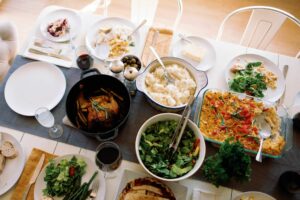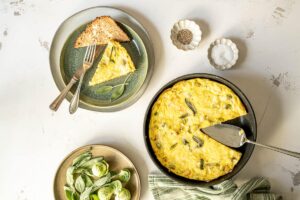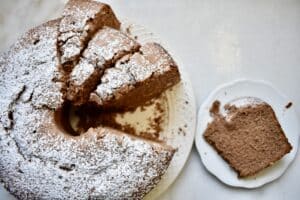
Start This Recipe 2-3 hours before eating (for unsoaked rice) or 8 hours before eating (for soaked rice)
Dinner Table Rating
1 thumb per family member
Cook’s Rating
Accessibility of ingredients, ease of preparation, and affordability
I admit, this is a humble recipe–a bowl of brown rice does not make for a “party in your mouth” experience. I have eaten bowl upon bowl full of rice over the past two years, due to chronic illness and lots of diet restrictions. I know my way around a pot of rice. But I have to tell you, this was a very exciting recipe for me.
When I first went down the path of extreme diet restrictions, I limited myself to white rice only, since it had less fiber and would be easier on my tummy. It also has a higher sugar content, which bothered me. I knew that brown rice has many vitamins and minerals (and a bit of protein) that was lacking in its refined counterpart. After about 6 months of white rice only, I thought I could surely handle a bowl of brown rice by this point, and devoured a large helping with dinner one night. I woke up at midnight with horrible stomach cramps, and haven’t tried it again since.
So when I cooked up these recipes, it was really just for the rest of the family to have with their dinner. But as I was cooking, I was reading in Sally’s notes about the digestive benefits of her ingredients and cooking techniques and I began to feel bold. So I ate some, too. Not just a spoonful or two, but an entire bowl. And did I wake up with horrible cramps? No, I absolutely did not. I know this may not sound noteworthy, but, my friends, this is HUGE. When you have not been able to even tolerate a bowl of brown rice for years, to suddenly be able to eat it again?? I repeat, HUGE!
Now, I’m the first to tell you that this was no scientific study. There are a number of factors at work here, not just Sally’s cooking methods. I’m sure time and healing had something to do with it, too. But I can’t completely discount Sally’s food wisdom and methods. So while it may not be exciting for you, it’s very exciting for me, to be able to recommend Sally’s Brown Rice with all 6 thumbs up. If it’s digestibility you’re after, I recommend the soaked version (Basic Brown Rice II), since I definitely noticed a difference between the two.
Basic Brown Rice I (unsoaked)
Unsoaked method requires about 3 hours before serving.
Source: Nourishing Traditions by Sally Fallon
Course: Side Dishes (Bread and Starches)
Serves:
Ingredients
- 2 cups long-grain brown rice
- 2 tablespoons butter (or coconut oil, for dairy-free)
- 2 tablespoons extra virgin olive oil
- 3 cardamom pods
- 4 cups chicken stock (or combination of stock and water)
- 1 tablespoon gelatin
- 1⁄2 teaspoon sea salt
Directions
- Directions found in Nourishing Traditions, page 466.
1. In a heavy, flameproof casserole, melt butter and olive oil. Open cardamom pods and add seeds to the casserole.
My diet is still dairy-free so I opted to use coconut oil instead of the butter here. I recommend it for your consideration, especially if you’re serving your rice with some Asian or Middle Eastern cuisine.
I really love cardamom and actually use it quite frequently. Typically, I use ground cardamom, but I do have a jar of cardamom pods on hand that I use whole in making hot drinks (like chai–YUM!). But somehow, it had never occurred to me that if I opened up one of these pods, I’d find seeds. So I sliced one open and, whaddya know, they’re filled with seeds. It was a fun discovery, but I actually didn’t prefer the crunchy seeds being in my rice, and will probably leave them out next time.
2. Saute rice in butter and oil, stirring constantly, until rice begins to turn milky. Pour in liquid, add salt and optional gelatin and bring to a rolling boil. Boil, uncovered, for about 10 minutes until water has reduced to the level of the rice.
Sally usually recommends soaking your grains. But in the case of rice she notes that it is relatively low in phytic acid (that enzyme in grain that inhibits digestion). So while most grains benefit from a long soaking, which neutralizes the phytic acid, it is generally suitable to cook rice with a long, slow steaming in broth
I didn’t use the gelatin, mostly because I don’t have any in my cupboard, but I did use homemade chicken stock that contains a fair amount of gelatin. I think if you’re using all stock or mostly stock, you could safely omit it. But if you’re going to use all water, I think it would be a good idea to include the gelatin since it is a digestive aid and helps your body to break down the grain.
3. Reduce flame to lowest heat, cover tightly and cook for at least 1 1/2 hours or as long as 3 hours. Do not remove lid during cooking.
I know that we are all impatient Americans and we just can’t stand to let something simmer without taking a peek. However, the best tip I ever got on rice cooking was “Do not disturb the pot!”. Don’t stir it. Don’t take off the lid. Don’t even sniff it. I know it’s hard. You’re worried that it’s scorching the bottom of your enameled pot. If you follow the directions here, no harm will come to your pot. Promise.
Basic Brown Rice II (soaked)
Allow about 8 hours before serving.
Source: Nourishing Traditions by Sally Fallon
Course: Side Dishes (Bread and Starches)
Serves:
Ingredients
- 2 cups long-grain or short-grain brown rice
- 4 cups warm water plus 4 tablespoons whey yogurt, kefir or buttermilk (or vinegar or lemon juice, for dairy-free)
- 1 teaspoon sea salt
- 2-4 tablespoons butter (or coconut oil, for dairy-free)
Directions
- Directions in Nourishing Traditions, page 467.
We found both of these versions to be very nice. The unsoaked version was firmer and had a more “toothy” texture. The soaked version was fluffy and creamy. Cook whichever one suits your taste preferences, and goes best with what you’re serving as a main course.









